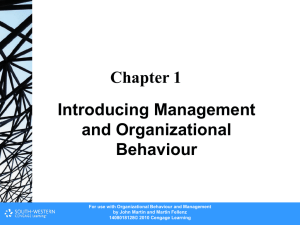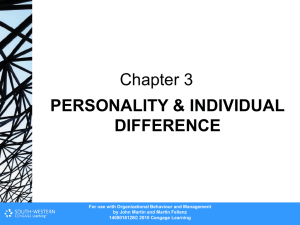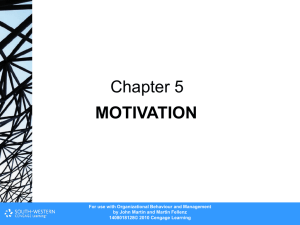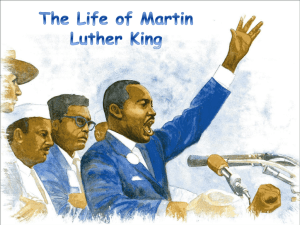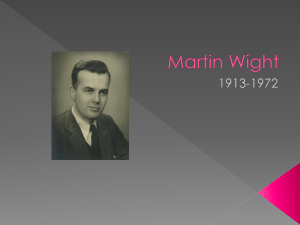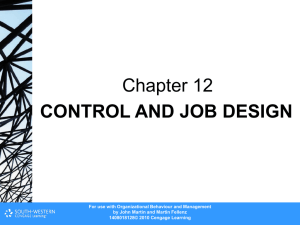CHAPTER 16 - Cengage Learning
advertisement
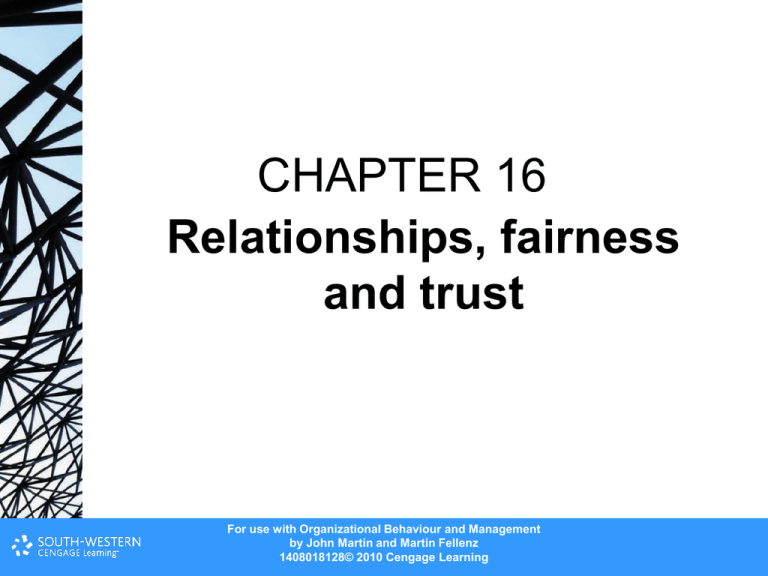
CHAPTER 16 Relationships, fairness and trust For use with Organizational Behaviour and Management by John Martin and Martin Fellenz 1408018128© 2010 Cengage Learning Relationships in organizations • Formal relationships - determined by roles and include: – authority relationships – workflow connections and task interdependencies – peer relationships in formal groups and units, and communication linkages • Informal relationships – include: – personal relationships among friends and acquaintances – informal relationships due to physical proximity – joint membership in informal groups – sources of repeated interactions For use with Organizational Behaviour and Management by John Martin and Martin Fellenz 1408018128© 2010 Cengage Learning Relationships in organizations • Relationships - important conduits of information and meaning in organizations • Close relationships can increase the psychological safety and the flow of information - benefits learning for the individuals and organization • Social support and positive relationships at work can improve functioning of cardiovascular, immune, and hormone systems • Positive social interactions increase physiological resourcefulness and physical health, which increase work engagement and hasten recovery from work-related strain and stress For use with Organizational Behaviour and Management by John Martin and Martin Fellenz 1408018128© 2010 Cengage Learning Relationships in organizations • Poor and conflictual relationships - negative implications include: – – – – – anxiety and stress, reduced communication quality and quantity, reduced information processing, task distraction and attitudinal changes including lower satisfaction and commitment • Poor relationships can impede performance at individual, group and organizational levels For use with Organizational Behaviour and Management by John Martin and Martin Fellenz 1408018128© 2010 Cengage Learning SOCIAL EXCHANGE THEORIES Common basic elements include: – the exchange rules and norms that determine interactions and – the obligations that arise from them for each partner, – the currency of exchange (i.e., the nature of the resources passed between the partners), and – the relationships that emerge between and among exchange partners For use with Organizational Behaviour and Management by John Martin and Martin Fellenz 1408018128© 2010 Cengage Learning SOCIAL EXCHANGE THEORIES • Classic contributions regard interpersonal relationships as exchanges in which each actor engages to maximize the value they receive • Value can differ on the dimension of: – tangible (e.g., goods) – intangible (e.g., status) – objectively and generally valuable (e.g., money) – subjectively and person-specifically valuable (e.g., love and affection) For use with Organizational Behaviour and Management by John Martin and Martin Fellenz 1408018128© 2010 Cengage Learning SOCIAL EXCHANGE THEORIES • Value from relationship behaviour can be derived from a range of sources, including: – normative (e.g., acting based on internalized social norms), – value-expressive (e.g., acting to display an aspirational self-image), and – affiliative, intrinsic and emotional (e.g., the feelings of contentment and joy from interacting with a partner) For use with Organizational Behaviour and Management by John Martin and Martin Fellenz 1408018128© 2010 Cengage Learning SOCIAL EXCHANGE THEORIES • Behaviour is influenced by rational considerations such as: – rewards and costs, and by – principles of rewards and punishment – over time many interactions within relationships become ritualistic and often automatic • Exchange based relationships endure over time only if there is positive value accruing to all partners • Thus, social exchange theory is in line with an Rational Choice Theory - describes human behaviour as driven by self-interest based on hedonistic (i.e., value-maximization) principles For use with Organizational Behaviour and Management by John Martin and Martin Fellenz 1408018128© 2010 Cengage Learning SOCIAL EXCHANGE THEORIES • Networking - the deliberate cultivation of positive relationships with individuals that may be helpful in direct exchanges or indirectly through their links to third parties • One use of social exchange theory is game theory - mathematical approaches to describe and analyze the interactions among parties – a classic example is the prisoner’s dilemma For use with Organizational Behaviour and Management by John Martin and Martin Fellenz 1408018128© 2010 Cengage Learning The prisoner’s dilemma Figure 16.1 For use with Organizational Behaviour and Management by John Martin and Martin Fellenz 1408018128© 2010 Cengage Learning MANAGING RELATIONSHIPS IN ORGANIZATIONS • People tend to like other people that are: – – – – similar to them in beliefs and interests that are skilled and competent in some way that have admirable characteristics or qualities that like them in return • Based on social exchange theory - people like those who provide them with maximum reward at minimum cost • In organizations, relationships are not purely determined by liking – and are often: – – – – more instrumental less discretionary more externally determined more situation dependent For use with Organizational Behaviour and Management by John Martin and Martin Fellenz 1408018128© 2010 Cengage Learning MANAGING RELATIONSHIPS IN ORGANIZATIONS • Many relationships in organizations exist between individuals of different authority levels • Both national and organizational culture can impact on intra-organizational relationships For use with Organizational Behaviour and Management by John Martin and Martin Fellenz 1408018128© 2010 Cengage Learning Activities that help to build and maintain relationships (1) In general, the activities that help to build and maintain relationships include supportive, appreciative, informative, inclusive, empowering, validating and respectful behaviours. Therefore: • Invite input in appropriate forms and at appropriate times • Show acceptance and validate at least some aspects of suggestions and opinions • Be direct and honest yet polite and courteous • Act friendly and show patience • Be considerate of specific needs, interests, and circumstances • Take the other’s emotional state into account (e.g., fear, anxiety, excitement) • Show your willingness to consider the other’s perspective For use with Organizational Behaviour and Management by John Martin and Martin Fellenz 1408018128© 2010 Cengage Learning Activities that help to build and maintain relationships (2) • Offer assistance with work when needed and appropriate • Avoid making decision that take responsibility away from the other • Keep an appropriate information flow that informs without overwhelming • Show confidence in the other’s abilities • Remember personal details regarding the person • Acknowledge all contributions and accomplishments • Provide autonomy, challenge and support in balanced ways • Validate the other’s identity and help maintain their sense of personal worth and importance • Act respectful at all times For use with Organizational Behaviour and Management by John Martin and Martin Fellenz 1408018128© 2010 Cengage Learning Relationships • Toxic relationships – unproductive, counterproductive or even harmful relationships • Assertiveness - a process of interpersonal communication that is respectful of both one’s own and the other party’s needs, rights and interests For use with Organizational Behaviour and Management by John Martin and Martin Fellenz 1408018128© 2010 Cengage Learning Assertiveness Assertive can address interpersonal and relationship problems because they (Bolton, 1979): – increase the probability that the other will alter the troublesome behaviour because they avoid reactance and defensiveness – are unlikely to violate the other person’s integrity or lower their self-esteem; – if planned and executed well contain a low risk of further damaging the relationship – express concern about the relationship and can help increase the other’s motivation to change – limit the further intensification of the problem and prevent defensiveness to escalate to destructive levels For use with Organizational Behaviour and Management by John Martin and Martin Fellenz 1408018128© 2010 Cengage Learning The three-part assertive message Table 16.1 For use with Organizational Behaviour and Management by John Martin and Martin Fellenz 1408018128© 2010 Cengage Learning The six steps of using assertive messages to address relationship problems Table 16.2 For use with Organizational Behaviour and Management by John Martin and Martin Fellenz 1408018128© 2010 Cengage Learning Advocacy and Inquiry • Advocacy - a process of undogmatic assertion that invites constructive engagement with the factual basis and logical argument supporting the assertion • Inquiry - a process of dialogue that constructively challenges others’ views by refocusing on facts and reasoning For use with Organizational Behaviour and Management by John Martin and Martin Fellenz 1408018128© 2010 Cengage Learning Advocacy and Inquiry Table 16.3 For use with Organizational Behaviour and Management by John Martin and Martin Fellenz 1408018128© 2010 Cengage Learning THE PSYCHOLOGICAL CONTRACT • Psychological contract - the individual beliefs about the terms of the mutual exchange agreement between the individual and their organization • Even well-meaning, legitimate behaviour by managers can violate individuals’ understanding of the psychological contract • Violations can lead to profound behavioural, cognitive and emotional reactions For use with Organizational Behaviour and Management by John Martin and Martin Fellenz 1408018128© 2010 Cengage Learning THE PSYCHOLOGICAL CONTRACT • Research indicates that violation can lead to: – – – – – – higher turnover and absenteeism lower job satisfaction increased cynicism lower organizational citizenship behaviour lower perceived support Reduced trust in the organization • Violations can be addressed in a number of ways: – that range from actual changes in the benefits and working conditions provided by the organization – justifying and reframing perceived shortcomings – interventions aimed at changing subjective expectations For use with Organizational Behaviour and Management by John Martin and Martin Fellenz 1408018128© 2010 Cengage Learning Organizational justice • Organizational justice - employees’ fairness perceptions regarding their work and conditions of employment and their behavioural reactions to this • A four-dimensional conception of OJ : – Distributive justice is concerned with individuals’ perceptions of the fairness of outcomes. – Procedural justice is concerned with the perceived fairness of the processes by which decisions are made. – Interactional justice is concerned with the fairness perceptions of the quality of interpersonal treatment – Informational justice is concerned with the fairness perceptions of information received For use with Organizational Behaviour and Management by John Martin and Martin Fellenz 1408018128© 2010 Cengage Learning Organizational justice Figure 16.2 For use with Organizational Behaviour and Management by John Martin and Martin Fellenz 1408018128© 2010 Cengage Learning Leventhal’s criteria of procedural fairness Table 16.4 For use with Organizational Behaviour and Management by John Martin and Martin Fellenz 1408018128© 2010 Cengage Learning TRUST IN ORGANIZATIONS • Trust - the degree to which a person is prepared to make themselves vulnerable to another person despite uncertainty about the other’s possible actions • A three-stage model trust development: – The first stage is deterrence-based trust – The second stage is knowledge-based trust – The third stage is Identification-based trust For use with Organizational Behaviour and Management by John Martin and Martin Fellenz 1408018128© 2010 Cengage Learning Determinants of trust Figure 16.3 For use with Organizational Behaviour and Management by John Martin and Martin Fellenz 1408018128© 2010 Cengage Learning TRUST IN ORGANIZATIONS • Miller and Bedford (2003) suggest a five step process as the way to (re-)establish trust at a company level: • Identify the core values • Bring the core values to life • Spell out the do and don’t aspects of each value • Weave values into the fabric of the organization • Ensure accountability and model the way For use with Organizational Behaviour and Management by John Martin and Martin Fellenz 1408018128© 2010 Cengage Learning Bilateral model of trust repair Figure 16.4 For use with Organizational Behaviour and Management by John Martin and Martin Fellenz 1408018128© 2010 Cengage Learning RESTORING TRUST • Substantive penance - includes the transfer of valuable resources in reparation for the violation • voluntary hostage posting - involves providing decision control over valuable resources of the trustee to the trustor For use with Organizational Behaviour and Management by John Martin and Martin Fellenz 1408018128© 2010 Cengage Learning Repairing broken trust Table 16.5 For use with Organizational Behaviour and Management by John Martin and Martin Fellenz 1408018128© 2010 Cengage Learning

